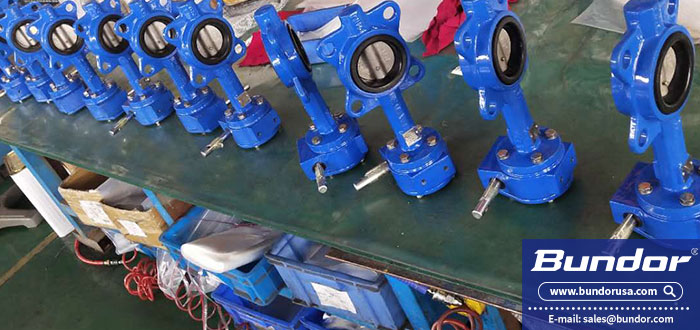The difference between rubber - lined butterfly valve and fluorine - lined butterfly valve
Posted by Bundor valve
Lining rubber butterfly valve lining rubber is the use of high temperature vulcanization of rubber and valve body into a body, has a very high corrosion resistance, generally used to control some acid alkaline strong corrosive fluid.
Rubber butterfly valve is a butterfly valve seal for rubber seal, commonly known as the seat, is separately installed into a body.
Under the circumstance of general normal temperature, the wear resistance of natural soft rubber is much better than that of nitrile rubber.

Full line butterfly valve and half line butterfly valve difference:
1, semi-lined butterfly valve refers to: butterfly valve is not lined with rubber, and the butterfly valve and the valve body connection place has lined with rubber;
2, fully lined butterfly valve refers to: butterfly valve disc and the parts connected with the valve body are lined with rubber.
The difference between rubber butterfly valve and plastic butterfly valve: rubber butterfly valve and fluorine butterfly valve are only one of the plastic butterfly valve.
Rubber lined butterfly valve sealing materials are: hard rubber NR applicable temperature: -10℃~85℃, soft rubber BR applicable temperature: -10℃~85℃, butyl glue IIR applicable temperature: -10℃~120℃, neoprene CR applicable temperature: -10℃~105℃;
Fluorine-butterfly butterfly valve sealing material has: poly perfluorinated ethylene FEP (F46) temperature: 85 ℃ ~ 150 ℃, poly tetrafluoroethylene PTFE (F4) temperature: 200 ℃ ~ 180 ℃, gathered three fluoride PCTEF (F3) temperature: 195 ℃ ~ 120 ℃, polypropylene: RPP temperature: - 14 ℃ ~ 80 ℃, polyvinyl chloride (PVC) : rigid PVC use temperature: 0 ℃ to 55 ℃, poly (vinylidene chloride PVDF (F2) temperature: 70 ℃ ~ 100 ℃, polyolefin: PO using temperature:- 58 ℃ ~ 80 ℃.
Rubber butterfly valve is a butterfly valve seal for rubber seal, commonly known as the seat, is separately installed into a body.
Under the circumstance of general normal temperature, the wear resistance of natural soft rubber is much better than that of nitrile rubber.

Full line butterfly valve and half line butterfly valve difference:
1, semi-lined butterfly valve refers to: butterfly valve is not lined with rubber, and the butterfly valve and the valve body connection place has lined with rubber;
2, fully lined butterfly valve refers to: butterfly valve disc and the parts connected with the valve body are lined with rubber.
The difference between rubber butterfly valve and plastic butterfly valve: rubber butterfly valve and fluorine butterfly valve are only one of the plastic butterfly valve.
Rubber lined butterfly valve sealing materials are: hard rubber NR applicable temperature: -10℃~85℃, soft rubber BR applicable temperature: -10℃~85℃, butyl glue IIR applicable temperature: -10℃~120℃, neoprene CR applicable temperature: -10℃~105℃;
Fluorine-butterfly butterfly valve sealing material has: poly perfluorinated ethylene FEP (F46) temperature: 85 ℃ ~ 150 ℃, poly tetrafluoroethylene PTFE (F4) temperature: 200 ℃ ~ 180 ℃, gathered three fluoride PCTEF (F3) temperature: 195 ℃ ~ 120 ℃, polypropylene: RPP temperature: - 14 ℃ ~ 80 ℃, polyvinyl chloride (PVC) : rigid PVC use temperature: 0 ℃ to 55 ℃, poly (vinylidene chloride PVDF (F2) temperature: 70 ℃ ~ 100 ℃, polyolefin: PO using temperature:- 58 ℃ ~ 80 ℃.
 简体中文
简体中文 Русский
Русский Español
Español Bundor - Butterfly, Gate, Check, Ball, Globe Valve Manufacturer, Supplier & Distributor
Bundor - Butterfly, Gate, Check, Ball, Globe Valve Manufacturer, Supplier & Distributor
